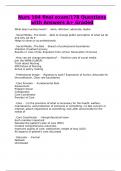Summary
HPI4004 Patient logistics in healthcare summary (year 2016/2017)
- Course
- Institution
Summary of the course HPI4004 Patient logistics in health care, including all essential elements of week 1, 2, 3 and 4 to study for the exam: - Summary per week - Learning goals per week - Online lectures and the discussed mind maps as a guide for the summary - Additional information from the lectu...
[Show more]












